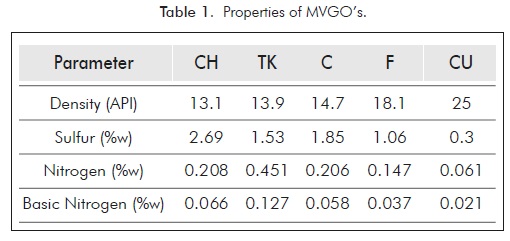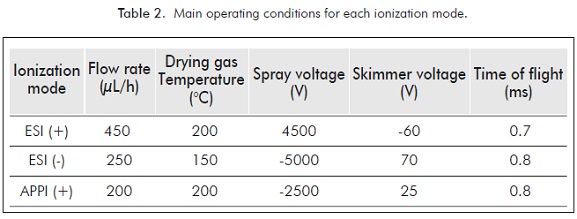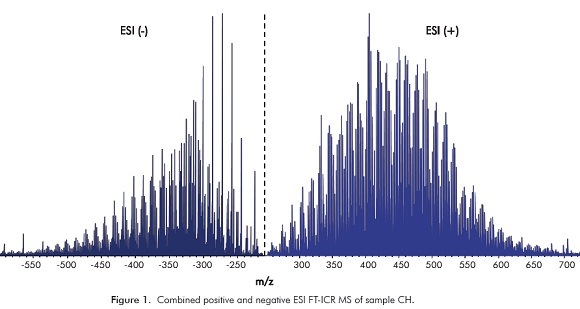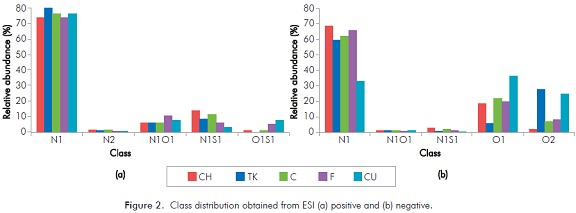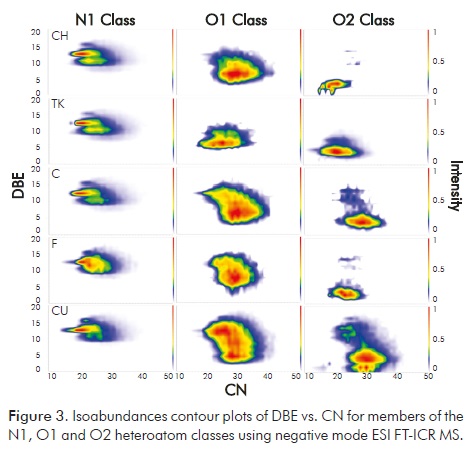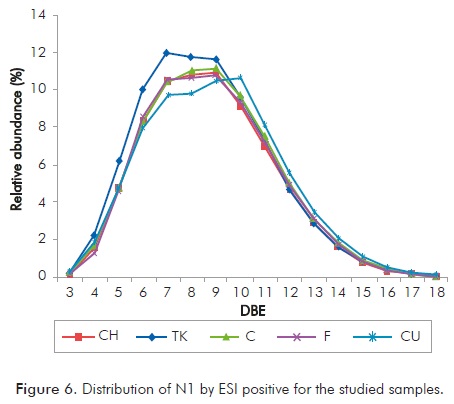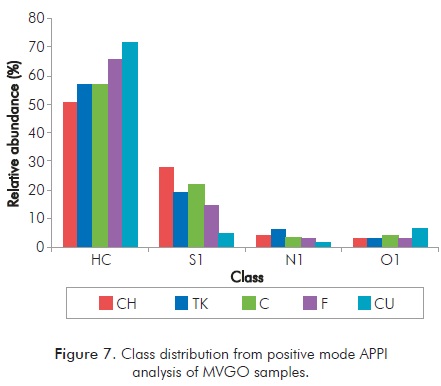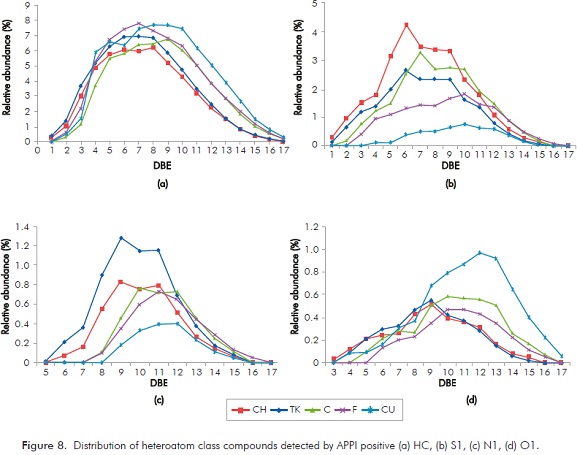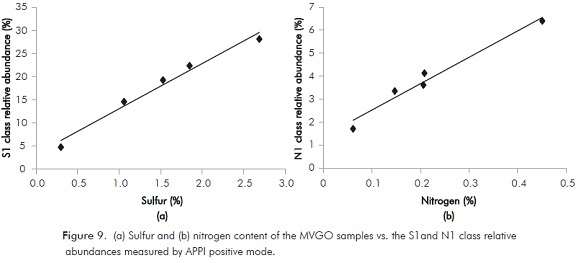Serviços Personalizados
Journal
Artigo
Indicadores
-
 Citado por SciELO
Citado por SciELO -
 Acessos
Acessos
Links relacionados
-
 Citado por Google
Citado por Google -
 Similares em
SciELO
Similares em
SciELO -
 Similares em Google
Similares em Google
Compartilhar
CT&F - Ciencia, Tecnología y Futuro
versão impressa ISSN 0122-5383
C.T.F Cienc. Tecnol. Futuro vol.6 no.1 Bucaramanga jan./jun. 2015
CHARACTERIZATION OF VACUUM GAS OILS USING FT-ICR MS
CARACTERIZACIÓN DE GASÓLEOS DE VACÍO USANDO FT-ICR MS
CARACTERIZAÇÃO DOS ÓLEOS DE GÁS NO VÁCUO UTILIZANDO FT-ICR MS
Andrea Gómez-Escudero*1, Fernando-Andrés Rojas-Ruíz2, Jorge-Armando Orrego-Ruíz1
1Laboratorio de Petroleómica FT-MS, Instituto Colombiano del Petróleo (ICP) - Ecopetrol S. A., A. A. 4185 Piedecuesta, Santander, Colombia, e-mail: andrea.gomezes@ecopetrol.com.co
2TIP Ltda, Bucaramanga, Santander, Colombia
How to cite: Gómez-Escudero, A., Rojas-Ruíz, F. A. & Orrego-Ruíz, J. A. (2015). Characterization of vacuum gas oils using FT-ICR MS. CT&F - Ciencia, Tecnología y Futuro, 6(1), 69-80.
*To whom correspondence should be addressed
(Received: Feb. 04, 2015; Accepted: Jun. 03, 2015)
ABSTRACT
The molecular composition of five Medium Vacuum Gas Oils (MVGOs) was studied using 15T Fourier Transform Ion Cyclotron Resonance Mass Spectrometry (FT-ICR MS) coupled with Electrospray Ionization (ESI) and atmospheric pressure photoionization (APPI). Class and Double Bond Equivalence (DBE) distribution of the MVGOs were compared; non-basic, basic nitrogen and oxygen compounds were detected using ESI negative and positive mode while aromatic hydrocarbons and sulfur species were visible via APPI. Compositional distributions revealed definitive heteroatom class and type trends among the MVGOs, and provide evidence of the relationship between chemical composition of gas oils (in terms of aromaticity, maturity and biodegradation) and some of its macroscopic properties such as API gravity. Furthermore, the observed class relative abundances matched well with the sulfur and nitrogen content determined for the MVGO’s by conventional methodologies. These preliminary approaches are here reported for Colombian gas oils for the first time, and afford as insight that it is possible to obtain semi quantitative information from FT-ICR MS experiments.
Keywords: Electrospray ionization, Atmospheric pressure photoionization, Fourier transform ion cyclotron resonance mass spectrometry, Medium vacuum gas oils.
RESUMEN
La composición molecular de cinco gasóleos medios de vacío (MVGO’s, de sus siglas en inglés) se estudió utilizando un espectrómetro de masas de resonancia de ion ciclotrón por transformada de Fourier de 15T (FT-ICR MS, de sus siglas en inglés), acoplado a Ionización por Electrospray (ESI, de sus siglas en inglés) y foto ionización a presión atmosférica (APPI, de sus siglas en inglés). La distribución de clases y dobles enlaces equivalentes (DBE, de sus siglas en inglés) fueron comparadas; compuestos con nitrógeno básico y no básico y oxígeno fueron detectados a través de ESI en modo negativo y positivo, mientras que hidrocarburos aromáticos y especies con átomos de azufre fueron obtenidos con APPI. La distribución composicional reveló tendencias entre las clases y los tipos de heteroátomos presentes en los MVGO, además se evidenció una relación entre la composición química de los gasóleos (relacionados con aromaticidad, madurez y biodegradación) y algunas de sus propiedades macroscópicas tales como la gravedad API. Adicionalmente, la abundancia relativa de las clases observadas correlacionó muy bien con el contenido de azufre y nitrógeno determinado para los gasóleos a través de métodos convencionales. Estos avances preliminares se reportan por primera vez para gasóleos Colombianos en este trabajo, y proporcionan la idea de que es posible obtener información semi cuantitativa a través de los experimentos de FT-ICR MS.
Palabras clave: Ionización por electrospray, Espectrometría de masas de resonancia de ion ciclotrón por transformada de Fourier, Gasóleos medios de vacío.
RESUMO
Acomposição molecular de cinco gasóleos de vácuo médios (MVGO’s por suas siglas em inglês) foi estudada utilizando um espectrômetro de massas de ressonância de íon cíclotron por transformada de Fourier de 15T (FT-ICR MS, por suas siglas em inglês), unido à Ionização por Electrospray (ESI, por suas siglas em inglês) e foto ionização a pressão atmosférica (APPI, por suas siglas em inglês). A distribuição de classes e ligações duplas equivalentes (DBE, por suas siglas em inglês) foram comparadas; compostos com nitrogênio básico e não básico e oxigênio foram detectados através do ESI em modo negativo e positivo, enquanto os hidrocarbonetos aromáticos e espécies com átomos de enxofre foram obtidos com APPI. A distribuição composicional revelou tendências entres as classes e os tipos de heteroátomos presentes nos MVGO, além disso verificou-se uma relação entre a composição química dos gasóleos (relacionados com aromaticidade, maturidade e biodegradação) e algumas propriedades macroscópicas como a gravidade API. Adicionalmente, a abundância relativa das classes observadas se correlacionou muito bem com o conteúdo de enxofre e nitrogênio determinado para os gasóleos através de métodos convencionais. Estes avances preliminares são relatados por primeira vez para gasóleos Colombianos neste trabalho e fornecem a ideia de que é possível obter informação semi-quantitativa através dos experimentos de FT-ICR MS.
Palavras-chave: Ionização por electrospray, Espectrometria de massas de ressonância de ion cíclotron por transformada de Fourier, Gasóleos de vácuo médios.
1. INTRODUCTION
It is considered that around 90 % of crude oil chemical composition mainly consists of hydrocarbons such as naphthenes, parafins and aromatics. The remaining 10 % is composed by molecules that, at least, contained one heteroatom like nitrogen, sulfur and oxygen (NSO), and metals such as vanadium and nickel, which are difficult to characterize due to their low concentration and high boiling points (Hughey et al., 2002; Hughet et al., 2004). The identification and characterization of these compounds is critical as they are associated with different operational problems within production, transport, refining and storage of crude oil and its by-products. Different analytical techniques for the characterization of the compositional diversity of these samples, including High Performance Liquid Chromatography (HPLC) and two-dimensional Gas Chromatography (GCxGC), are usually employed to characterize crude oil fractions (Reddy et al., 2007). Despite HPLC have been used to analyze heavy oils and vacuum residue fractions (Ueda et al., 1991), conventional chromatographic techniques allow addressing just bulk physicochemical properties and have a better performance with low boiling point fractions due to the samples complexity that exponentially rises as their boiling points increase. Additional techniques such as Nuclear Magnetic Resonance (NMR), Fourier Transform Infrared (FTIR) and X-ray Photoelectron Spectroscopy (XPS) are also used for compositional characterization but, generally previous separation and fractionation are needed (Pruski, De la Rosa & Gerstein, 1990; Kelemen et. al., 1998; D’Alessio, Vergamini & Benedetti, 2000). Techniques such as Gas Chromatography (GC), Supercritical Fluid Chromatography (SFC), among others have been coupled to Mass Spectrometry (MS) to provide detailed characterization of crude oil composition (Damsté et al., 1999). However, GC and SFC are conceived for petroleum distillates including heavy fractions (Dutriez et al., 2010), while SFC has shown very poor resolution capability for residual samples (Dutriez et al., 2013).
Polar molecules in petroleum were first studied using Electrospray Ionization (ESI) mass spectrometry by Zhan and Fenn (2000), because ESI selectively ionizes acidic and basic polar heteroatom containing compounds; however, deficient resolution power for complete compositional assignment was an issue at the time (Brown & Rice, 2000; Oro & Lucy, 2013). On the other hand, atmospheric pressure photoionization (APPI) coupled to MS is well suited for the characterization of aromatics (both polar and non-polar) and non-polar species such as sulfur compounds in crude oils (Cunico, Sheu & Mullins, 2004; Kim & Kim, 2010).
Chemical composition of petroleum kept unraveling after the contribution of Comisarow and Marshall (1974) who introduced and applied Fourier Transform Ion Cyclotron Resonance Mass Spectrometry (FT-ICR MS) to the study of petroleum; recently a term known as “petroleomics” was coined to describe the technique, since it responded to the resolution power drawbacks (Marshall & Rodgers, 2004; Marshall & Rodgers, 2008). Peaks that appear over a wide dynamic range introduce complexity to the FT-ICR MS broadband spectra of petroleum. Indeed, a single spectrum can contain more than 50000 peaks. The ultrahigh mass resolution and high mass accuracy capability of FT-ICR MS with data visualization and interpretation tools facilitate the identification of organic molecules in petroleum.
Molecular composition of different petroleum gas oils have been studied by means of ESI and/or APPI coupled to FT-ICR MS. Basic nitrogen containing compounds were characterized by positive-ion ESI FT-ICR MS, and these results were compared to those obtained by Gas Chromatography Mass Spectrometry (GC-MS), showing that only the major class N1 is totally detected by both techniques (Bauserman, Nguyen & Mushrush, 2004; Shi et al., 2010). Moreover, Klein, Rodgers and Marshall (2006) identified the hydrotreatment-resistant heteroatomic species in a crude oil distillation cut by both positive and negative ion electrospray ionization FT-ICR MS, finding that these compounds typically contain a single nitrogen atom within pyridinic or pyrrolic moieties. In the present study, the molecular composition of five colombian Medium Vacuum Gas Oils (MVGO’s) was studied using 15T FT-ICR MS coupled with ESI and APPI. The combined approach led to the identification of numerous chemical components in these samples and provided evidence of the relationship between chemical composition of gas oils such as aromaticity, maturity and biodegradation and some of its macroscopic properties such as API gravity. Additionally, the observed class relative abundances matched well with the sulfur and nitrogen content determined for the MVGO’s by conventional methodologies. These preliminary approaches are here reported for Colombian gas oils for the first time, and afford as insight that it is possible to obtain quantitative information from FT-ICR MS.
2. EXPERIMENTAL SECTION
Samples and Characterization
MVGO’s 427 - 482 °C were obtained following the method ASTM D5236-13 from atmospheric residual (370°C+). Samples were characterized in terms of density and sulfur and nitrogen contents. Sulfur and nitrogen content were measured with an ANTEK 7000S pyro fluorescence analyzer (ANTEK Instruments, Inc., USA) using the ASTM D5453-12 and ASTM D5762-12 standard methods respectively, while density was evaluated using the ASTM D287-12b method. MVGO’s codification and determined properties are laid out in Table 1. Basic nitrogen was determined according to the ASTM UOP269-10.
FT-ICR Mass Spectrometry
Studies were conducted with a 15T SolariX FT-ICR mass spectrometer from Bruker Daltonics (Billerica, MA). Nitrogen was used as drying and nebulizing gas. Argon was used in the collision cell and the prepared samples were directly injected with a syringe pump (Harvard, Holliston, MA). Stock sample solutions were prepared by diluting the samples to a concentration of ~10 mg/mL in toluene.
For ESI analysis, 0.2 mg/mL solutions in methanol were used and spiked with 1% (V/V) formic acid and 1% (V/V) ammonium hydroxide before sample loading, to improve ion detection in positive and negative ion mode, respectively. Both High Performance Liquid Chromatography (HPLC) grade methanol and toluene were purchased from Merck (Gibbstown, NJ). The operating parameters for ESI positive analyses were sample injection at a flow rate of 250 μL/h, drying gas temperature of 150°C and spray voltage of -5000 V; the skimmer voltage was set to 70 V to minimize in-source fragmentation. Ionized samples were accumulated in the collision cell for 0.05 s and transferred to the ICR cell with a 0.8 ms time of flight window (Table 2). ESI negative analyses were carried out using a sample flow rate of 450 μL/h, drying gas temperature of 200°C and spray voltage of 4500 V; -60 V for skimmer voltage and a time of flight window of 0.7 ms (Table 2).
In the case of APPI positive mode, stock solutions were diluted with toluene to a final concentration of 0.2 mg/mL. Samples were injected at a flow rate of 200 μL/h, drying gas temperature of 200°C and spray voltage of -2500 V, skimmer voltage was set to 25 V and 0.8 ms was used as the time of flight window (Table 2).
Data was acquired in broadband mode using 4 megaword data sets, with each mass spectrum resulting from the sum of 100 scans. Internal spectral calibration was performed using a homologous series CxHyO2 DBE 12 for ESI (-), CxHyN DBE 11 for ESI (+) and CxHy DBE 8 for APPI (+) using Data Analysis version 4.0 (Bruker Daltonics). Peaks with relative abundance higher than 10 times the S/N were exported to excel in .acs format. Compositional assignment was done using Composer software version 1.0.6 (Sierra Analytics, Modesto, CA, USA) with 1 ppm tolerance.
3. RESULTS AND DISCUSSION
Figure 1 shows the combined positive-ion (right) and negative-ion (left) ESI FT-ICR MS of MVGO CH. In both cases more than 10000 peaks were detected with a resolution power of 600000 at m/z (mass to charge ratio) 400. A wider and gaussian distribution of compounds is observed in ESI (+), which goes from m/z 250 to m/z 700 with a maximum at around m/z 420. Regarding ESI negative a non completed Gaussian distribution is observed because some classes like N1 presents bimodal distribution of their molecules. It is possible to resolve and identify basic (right) and acidic (left) species.
Class distributions for the ESI spectra of the five gas oil samples are displayed in Figure 2. The sum of relative abundances (%) of all classes reported is above 95 % and only the classes with more than 1 % abundance were reported. According to the data, the most abundant class is N1 for both ionization modes. ESI positive mode class distribution is governed by N1 class which are pyridinic compounds (basic nitrogen), an average of 70 % relative abundance was obtained for all samples; although there are other classes detected (N2, N1O1, N1S1 and O1S1), and their abundances are less than 10 %. In the case of ESI negative mode, three classes with abundances over 10 % are detected. N1 class, pyrrolic compounds usually termed as “neutral nitrogen” (slightly acidic from the ionization mode achieved), revealed abundances between 35 % (CU) to 60-70 % (CH, TK, C, F). Additionally, O1 and O2 classes, acidic oxygen compounds. i.e., phenols and carboxylic acids, are present in these samples. CU was found to show the highest O1 abundance, comparable to the abundance obtained for N1. Even though the samples were plotted in an increasing order of API gravity, none of the classes followed a tendency.
N1, O1 and O2 Distributions in ESI Spectra
To compare the distribution of classes N1, O1 and O2 at the molecular level, data were further analyzed using iso-abundance contour plots of DBE vs. carbon number (Figure 3). The color intensity scale of the plot represents the relative abundance observed in the spectra. The Double Bond Equivalence (DBE) values of the compounds were calculated by the expression DBE = c - h/2 + n/2 + 1, for neutral molecules having a generic composition CcHhNnOoSs. DBE basically indicates hydrogen deficiency of a given molecular formula namely related to aromaticity, and is commonly used to study high-resolution mass spectra of crude oil (Muller, Hajji & Koseoglu, 2007).
In the case of N1 class compounds, DBE vs. CN contour plots exhibit two intense distributions at DBE 10 and DBE 12. N1 class compounds with DBE 10 could be assigned to naphtocarbazole structures and those with DBE 12 to benzocarbazole structures. It is remarkable that benzocarbazole molecules which additionally have less carbon number and therefore lower molecular weights are more intense than naphtocarbazole molecules. Having into account that N1 compounds are the more abundant in samples, this is the reason why the ESI negative spectrum is not a Gaussian distribution (Figure 1). Hughey, Galasso and Zumberge (2007) and later Pan et al. (2013) used ESI FT-ICR MS to probe nitrogen, sulfur, and oxygen (NSO) compounds of both surface and reservoir biodegraded oils, and according to this study, the presence of these kinds of structures could be used as an indication of the maturity of the corresponding starting crude oils. O1 is the second most abundant heteroatom class detected by negative ion ESI. O1 species are most likely components with a hydroxyl functional group able to be deprotonated. In general a continuous and broader DBE distribution is observed for this class that starts in DBE 3 and finishes at DBE 15 for all samples. O2 class could be assigned to carboxylic and/or napthenic acids which are strong acids among the polar acidic compounds in the samples, and thus they are ionized by deprotonation much more effectively than other less acidic compounds present (Qian et al., 2008; Mapolelo et al., 2011). It is noticeable how the carbon number shifted to higher CN values, as it goes from 18 (CH) to 30 (CU). Also, DBE >8 distributions are observed for the gas oils C and CU, which can be a sign of the presence of highly condensate O2 compounds within these two samples.
By plotting the class’s abundance against the DBE distribution, it is possible to estimate the relative concentration changes by DBE groups in the whole set of samples. A reduction in total N1 species is revealed by means of this plot following the order set up for the studied samples (Figure 4). Moreover, this decrease in the relative concentration of all N1 class components is observed linked to an increasing API gravity of the corresponding parent crude oils; hence, based on API gravity, CU is the most mature sample while CH is the less mature among the analyzed samples.
Distribution of O1 class compounds exhibits a maximum DBE of 6 for CH, TK and C. For F and CU DBE values are shifted to 7 and 12, respectively. Note that CU covers a broader range of DBE. Because negative ESI is less effective for ionization of hydroxyl compounds compared to carboxylic acids, the high abundance of O1 class species are likely due to high concentrations of sterol-like compounds in the crude oil (Hughey et al., 2002).
DBE distribution for O2 class compounds displays its highest relative abundance for TK at DBE 3 (Figure 4). For CU a wider distribution was detected going from DBE 1 to 16. O2 class highly condensed (DBE >10) had an intensity non despicable for CU, which could be related with biodegradation of the starting crude oil. It is known that biodegradation could be assessed through O2 compound concentration, following a compositional shift from high-condensed to low condensed O2 compounds, therefore suggesting that TK and CU can be considered as the more biodegraded crude oils (Vaz et al., 2013).
Despite the well-established FT-ICR MS characterization of crude oil samples, to the best of our knowledge no systematic studies have dealt with biodegradation in gas oils and its relation with their parent crude oils. Kim et al. (2005) were the first to propose a biodegradation index based on O2 profile on crude oils, which was termed the A/C ratio (acyclic to cyclic naphthenic acids). This index is computed from the sum of ion abundances of the acyclic (DBE = 1) O2 species divided by the sum of ion abundances of the mono-, di-, and tricyclic acids (DBE = 2, 3, and 4, respectively). The A/C ratio showed a good correlation with degree of biodegradation of some crude oils, but its extension to the corresponding distillation fractions has not been established. Taking into account these results, we aimed to determine the relationships for higher DBEs (>10) and lower DBEs (<10) for the compound classes O1, O2 and N1 detected by ESI negative mode. Values reported in Figure 5 correspond to the ratio between the sum of intensities of DBE 11-20 and the sum of intensities of DBE 1-10 for the studied MVGO’s. CU had high values for classes O1, O2 and N1 indicating that its composition corresponds mainly to molecules with high DBE, which certainly is associated with its elevated maturity. Conversely, CH and TK had the lowest values for API and the minor ratios for O1, O2 and N1. These results reveal that there is a correlation between aromaticity in these classes and the API gravity of the samples (Figure 5).
Positive mode ESI is more sensitive toward basic nitrogen compounds such as pyridine analogs (Shi et al., 2010). N1 compounds with DBE 7 had the maximum abundance for TK, compounds to which quinolinic structures can be assigned (Figure 6). DBE 10 presumably naphtobenzoquinolines, was found most intense for CU which is an indicative of higher aromaticity (Figure 6). Samples TK, C and F showed maxima at DBE 9, which can represent benzoquinolines and/or dinapthoquinolines. Since CU displays the highest aromatic structure with main compounds with DBE 10 within the N1 class (naphtobenzoquinolines), it indicates that CU is the more mature crude oil among the studied samples (Oldenburg et al., 2014). This outcome is consistent with the results obtained from ESI negative mode.
Class and DBE distribution in Positive-Mode APPI FT-ICR MS Analysis
APPI class relative intensities are displayed in Figure 7. The graph shows only the main classes detected, i.e., HC, S1, N1 and O1 (which were the radical cation species). In general, for all samples aromatic hydrocarbon (HC) class shows the highest abundance followed by S1, N1 and O1. Sample CH displays the lower abundance for class HC and higher abundance for sulfur compounds. It is noticeable how HC abundance rises as the API increases. Once more CU showed the highest concentration of O1 compounds as determined via negative mode ESI.
Figure 8 shows a detailed distribution of HC, S1, N1 and O1 classes determined via APPI. DBE distribution for HC class has a maximum at 7 for CH, TK and F, while for CU and C the DBE is shifted toward higher values. These results suggest a different condensation degree in CU and C respect to the rest of the samples, which is consistent with a higher thermal maturity for the CU sample, as discussed before.
Sulfur species such as benzothiophenes (DBE 6) and dibenzothiophenes (DBE 10) are organic sulfur compounds present in the oils and their relative abundance are strongly affected by the level of oil maturity (Radke & Willsch, 1991). Results from Figure 8 show that S1 class is more abundant and is dominated by DBE 6 in CH, TK and C, which are the less mature samples. As the maturity increases, the S1 class relative abundance decreases, as it is perceived for F and CU where higher DBE (10) dominates the distribution.
A similar trend, i.e., shifting toward more condensed aromatic structures, is seen for N1 class. Gas oils CH and TK are dominated by DBE 9 (quinoline structure). At moderate maturity, sample C contains structures with more aromatic cores, predominant within the heteroatom class benzoquinolines (DBE 9). The more mature sample CU exhibits DBE 13, which indicates highly condensed aromatic core structures that might be naphthodibenzoquinolines.
DBE changes toward more aromatic O1 structures (most likely phenolic compounds) for CU are observed while, CH and TK displays less aromatic compounds for this class. It is important to recall that the same trend was observed in ESI negative mode regarding O1 class. These findings allow to stand that aromatization is again determined following thermal maturity, i.e., increasing API.
Finally, it is interesting to show a correlation between the measured sulfur (ASTM D5453-12), nitrogen (ASTM D5762-12) and the relative abundances of class S1 and N1 detected by APPI (+) (see Figure 9). This is a strong indicative that APPI (+) mode could offer quantitative results for sulfur and nitrogen compounds. Comparable results have been reported by Muller et al. (2012) by FT-ICR MS using both APPI and ESI ionization modes, affording a quantitative characterization of the sulfur aromatic compounds present in different gasoil samples.
4. CONCLUSION
Bulk properties analytical techniques can provide information about MVGO´s chemical composition; however, not to molecular level detail. In contrast, ESI and APPI FT-ICR MS provide detailed molecular characterization of these samples. Here, we have assigned and sorted molecular structures for five Colombian MVGO´s, rendering possible to follow their biodegradation and maturity changes. We find that polar compounds allowed differentiating the samples according to class (N, S, and O) and type (DBE), and so it was possible to propose the biodegradation and maturity grades for their parent crudes. This study reveals that it was possible to establish a correlation between density (API gravity) and the ratio between the sum of intensities of DBE 11-20 and the sum of intensities of DBE 1-10 for N1 and O1 classes detected by ESI (-). Also, the relative intensities for S1 and N1 by APPI (+) were correlated with sulfur and nitrogen contents measured by ASTM methods. These outcomes open the possibility to further investigate a way to foretell and quantify the chemical composition of MVGO samples.
ACKNOWLEDGEMENTS
The authors thank the Ecopetrol S. A. - Instituto Colombiano del Petróleo (ICP) for giving us the opportunity to publish the results and Dr. Martin Mojica for the helpful discussions.
REFERENCES
ASTM D287-12b. Standard Test Method for API Gravity of Crude Petroleum and Petroleum Products (Hydrometer Method). Annual Book of ASTM Standards, Vol. 05.02, ASTM International, West Conshohocken, PA, 2012. [ Links ]
ASTM D5236-13. Standard Test Method for Distillation of Heavy Hydrocarbon Mixtures (Vacuum Potstill Method). Annual Book of ASTM Standards, Vol. 05.02, ASTM International, West Conshohocken, PA, 2013. [ Links ]
ASTM D5453-12. Standard Test Method for Determination of Total Sulfur in Light Hydrocarbons, Spark Ignition Engine Fuel, Diesel Engine Fuel, and Engine Oil by Ultraviolet Fluorescence. Annual Book of ASTM Standards, Vol. 05.02, ASTM International, West Conshohocken, PA, 2012. [ Links ]
ASTM D5762-12. Standard Test Method for Nitrogen in Petroleum and Petroleum Products by Boat-Inlet Chemiluminescence. Annual Book of ASTM Standards, Vol. 05.02, ASTM International, West Conshohocken, PA, 2012. [ Links ]
ASTM UOP269-10. Nitrogen Bases in Hydrocarbons by Potentiometric Titration, ASTM International, West Conshohocken, PA, 2010. [ Links ]
Bauserman, J. W., Nguyen, K. M. & Mushrush, G. W. (2004). Nitrogen compound determination and distribution in three source fuels by GC/MS. Petrol. Sci. Technol., 22(11-12), 1491-1505. [ Links ]
Brown, T. L. & Rice, J. A. (2000). Effect of experimental parameters on the ESI FT-ICR mass spectrum of fulvic acid. Anal. Chem., 72(2), 384-390. [ Links ]
Comisarow, M. B. & Marshall, A. G. (1974). Fourier transform ion cyclotron resonance mass spectroscopy. Chem. Phys. Lett., 25(2), 282-283. [ Links ]
Cunico, R. L., Sheu, E. Y. & Mullins, O. C. (2004). Molecular weight measurements of UG8 asphaltene using APCI mass spectrometry. Petrol. Sci. Technol., 22(7-8), 787-798. [ Links ]
D'Alessio, A., Vergamini, P. & Benedetti, E. (2000). FT-IR investigation of the structural changes of Sulcis and South Africa coals under progressive heating in a vacuum. Fuel, 79(10), 1215-1220. [ Links ]
Damsté, J. S. S., White, C. M., Green, J. B. & de Leeuw, J. W. (1999). Organosulfur compounds in sulfur-rich Rasa coal. Energy Fuels, 13(3), 728-738. [ Links ]
Dutriez, T., Courtiade, M., Thiébaut, D., Dulot, H. & Hennion, M. C. (2010). Improved hydrocarbons analysis of heavy petroleum fractions by high temperature comprehensive two-dimensional gas chromatography. Fuel. 89(9), 2338-2345. [ Links ]
Dutriez, T., Thiébaut, D., Courtiade, M., Dulot, H., Bertoncini, F. & Hennion, M. C. (2013). Application to SFC-GC × GC to heavy petroleum fractions analysis. Fuel, 104: 583-592. [ Links ]
Hughey, C. A., Galasso, S. A. & Zumberge, J. E. (2007). Detailed compositional comparison of acidic NSO compounds in biodegraded reservoir and surface crude oils by negative ion electrospray Fourier transform ion cyclotron resonance mass spectrometry. Fuel, 86(5-6), 758-768. [ Links ]
Hughey, C. A., Rodgers, R. P., Marshall, A. G., Qian, K. & Robbins, W. K. (2002). Identification of acidic NSO compounds in crude oils of different geochemical origins by negative ion electrospray Fourier transform ion cyclotron resonance mass spectrometry. Org. Geochem., 33(7), 743-759. [ Links ]
Hughey, C. A., Rodgers, R. P., Marshall, A. G., Walters, C. C., Qian, K. & Mankiewicz, P. (2004). Acidic and neutral polar NSO compounds in Smackover oils of different thermal maturity revealed by electrospray high field Fourier transform ion cyclotron resonance mass spectrometry. Org. Geochem., 35(7), 863-880. [ Links ]
Kelemen, S. R., Gorbaty, M. L., Kwiatek, P. J., Fletcher, T. H., Watt, M., Solum, M. S. & Pugmire, R. J. (1998). Nitrogen transformations in coal during pyrolysis. Energy Fuels, 12(1), 159-173. [ Links ]
Kim, Y. H. & Kim, S. (2010). Improved abundance sensitivity of molecular ions in positive-ion APCI MS analysis of petroleum in toluene. J. Am. Soc. Mass Spectrom., 21(3), 386-392. [ Links ]
Kim, S., Stanford, L. A., Rodgers, R. P., Marshall, A. G., Walters, C. C., Qian, K., Wenger, L. M. & Mankiewicz, P. (2005). Microbial alteration of the acidic and neutral polar NSO compounds revealed by Fourier transform ion cyclotron resonance mass spectrometry. Org. Geochem., 36(8), 1117-1134. [ Links ]
Klein, G. C., Rodgers, R. P. & Marshall, A. G. (2006). Identification of hydrotreatment-resistant heteroatomic species in a crude oil distillation cut by electrospray ionization FT-ICR mass spectrometry. Fuel, 85(14-15), 2071-2080. [ Links ]
Mapolelo, M. M., Rodgers, R. P., Blakney, G. T., Yen, A. T., Asomaning, S. & Marshall, A. G. (2011). Characterization of naphthenic acids in crude oils and naphthenates by electrospray ionization FT-ICR mass spectrometry. Int. J. Mass Spectrom., 300(2-3), 149-157. [ Links ]
Marshall, A. G. & Rodgers, R. P. (2004). Petroleomics: The next grand challenge for chemical analysis. Acc. Chem. Res., 37(1), 53-59. [ Links ]
Marshall, A. G. & Rodgers, R. P. (2008). Petroleomics: Chemistry of the underworld. Proc. Natl. Acad. Sci. USA, 105(47), 18090-18095. [ Links ]
Mochida, I. & Choi, K. (2004). An overview of hydrodesulfurization and hydronitrogenation. J. Jpn. Petrol. Inst., 47: 145-163. [ Links ]
Muller, H., Adam, F. M., Panda, S. K., Al-Jawad, H. H. & Al-Hajji, A. A. (2012). Evaluation of quantitative sulfur speciation in gas oils by Fourier transform ion cyclotron resonance mass spectrometry: Validation by comprehensive two-dimensional gas chromatography. J. Am. Soc. Mass Spectrom., 23(5), 806-815. [ Links ]
Muller, H., Hajji, A. A. & Koseoglu, O. R. (2007). Chemindex 2007 Proceedings - Extended Abstracts. Manama, Bahrain. [ Links ]
Oldenburg, T. B. P., Brown, M., Bennett, B. & Larter, S. R. (2014). The impact of thermal maturity on the composition of crude oils, assessed using ultra-high resolution mass spectrometry. Organic Geochem., 75: 151-168. [ Links ]
Oro, N. E. & Lucy, C. A. (2013). Analysis of the nitrogen content of distillate cut gas oils and treated heavy gas oils using normal phase HPLC, fraction collection and petroleomic FT-ICR MS data. Energy Fuels, 27(1), 35-45. [ Links ]
Pan, Y., Liao, Y., Shi, Q. & Hsu, C. S. (2013). Acidic and neutral polar NSO compounds in heavily biodegraded oils characterized by negative-ion ESI FT-ICR MS. Energy Fuels, 27(6), 2960-2973. [ Links ]
Pruski, M., De la Rosa, L. & Gerstein, B. C. (1990). Effect of sample spinning on detection of carbon-13 NMR in coals. Energy Fuels, 4(2), 160-165. [ Links ]
Qian, K., Edwards, K. E., Dechert, G. J., Jaffe, S. B., Green, L. A. & Olmstead, W.N. (2008). Measurement of Total Acid Number (TAN) and TAN boiling point distribution in petroleum products by electrospray ionization mass spectrometry. Anal. Chem., 80(3), 849-855. [ Links ]
Radke, M. & Willsch, H. (1991). Occurence and thermal evolution of methylated benzo- and dibenzothiphenes in petroleum source rocks of western Germany. In: Manning, D. (ed), Organic geochemistry. Advances and applications in energy and the natural environment. Manchester: Manchester University Press, 480-484. [ Links ]
Reddy, C. M., Nelson, R. K., Sylva, S. P., Xu, L., Peacock, E. A., Raghuraman, B. & Mullins, O. C. (2007). Identification and quantification of alkene-based drilling fluids in crude oils by comprehensive two-dimensional gas chromatography with flame ionization detection. J. Chromatogr. A., 1148(1), 100-107. [ Links ]
Shi, Q., Xu, C., Zhao, S., Chung, K. H., Zhang, Y. & Gao, W. (2010). Characterization of basic nitrogen species in coker gas oils by positive-ion electrospray ionization Fourier transform ion cyclotron resonance mass spectrometry. Energy Fuels, 24(1), 563-569. [ Links ]
Ueda, K., Matsui, H., Malhotora, R. & Nomura, M. (1991). Chemical characterization of heavy oils using HPLC/FI-MS analysis of a petroleum vacuum residue. J. Jpn. Petrol. Inst., 34(1), 62-70. [ Links ]
Vaz, B. G., Silva, R. C., Klitzke, C. F., Simas, R. C., Lopes, H. D., Pereira, R. C. L., Garcia, D. F., Eberlin, M. N. & Azevedo, D. A. (2013). Assessing biodegradation in the Llanos Orientales crude oils by electrospray ionization ultrahigh resolution and accuracy Fourier transform mass spectrometry and chemometric analysis. Energy Fuels, 27(3), 1277-1284. [ Links ]
Zhan, D. & Fenn, J. B. (2000). Electrospray mass spectrometry of fossil fuels. Int. J. Mass Spectrom., 194(2-3), 197-208. [ Links ]
AUTHORS
Andrea Gómez-Escudero
Affiliation: Ecopetrol S.A. - Instituto Colombiano del Petróleo (ICP)
Chemist, Universidad del Quindio
M.Sc. in Chemistry, University of Massachusetts
Ph. D. in Chemistry, University of Massachusetts
e-mail: andrea.gomezes@ecopetrol.com.co
Fernando-Andrés Rojas-Ruíz
Affiliation: TIP
Chemist, Universidad Industrial de Santander
M.Sc. in Chemistry, Universidad Industrial de Santander
e-mail: fernandoan.rojas@ecopetrol.com.co
Jorge-Armando Orrego-Ruíz
Affiliation: Ecopetrol S.A. - Instituto Colombiano del Petróleo (ICP)
Chemist, Universidad Industrial de Santander
M.Sc. in Chemistry, Universidad Industrial de Santander
Ph. D. in Chemistry, Universidad Industrial de Santander
e-mail: jorge.orrego@ecopetrol.com.co













